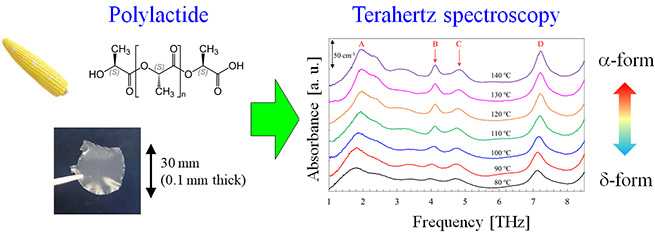
ここからコンテンツです。

Terahertz-waves provide a new method to analyze biomass-based plastic
Towards the elucidation of the origin of absorption spectra and the development of materials with new functions Satoshi Ohnishi, Atsushi Ebata, and Seiichiro Ariyoshi
The collaborative research team formed by the Electronics-Inspired Interdisciplinary Research Institute (EIIRIS) and the Department of Applied Chemistry and Life Science of Toyohashi University of Technology and Osaka Institute of Technology employed terahertz-waves, located in the gap between radio-waves and light-waves, as observation probes, and conducted broadband terahertz (THz) spectroscopy analysis on polylactide (PLA) with different polymer crystal structures. As a result, differences in higher-order structure, which are hard to reveal through conventional methods such as X-ray diffraction, were successfully detected with high precision from differences in THz absorption peaks. This achievement suggests that terahertz-waves have the potential to enable the detection of differences in the complex higher-order structures of PLAs and other biomass-based plastics.
The results of this research were published online on Materials Advances of the Royal Society of Chemistry on June 2nd and selected as an Inside Back Cover on July 21st.
Since polymers (plastics) were first created synthetically, metal, glass, and wooden products have been replaced with plastics and our lives in modern society are supported by a large number of plastic products. At the same time, due to the current problems of marine pollution caused by microplastics and carbon dioxide (CO2) emitted in the plastic manufacturing process, there is a strong need to use environmentally friendly plastics. Against this backdrop, biomass-based plastic is drawing attention as it is biodegradable and highly carbon-neutral. Basically, polymer properties such as hardness, fragility, workability, and thermal stability are determined not only by the chemical composition but also by the higher-order structure related to the crystallinity, molecular chain length, and chain packing in the solid state.
However, unlike the more commonly used petroleum-based plastic, the history of biomass-based plastic is short, so the lack of fundamental understanding with respect to its high-order structure and physical properties has hindered its widespread adoption. There is a strong need to establish a non-destructive and non-invasive analysis technology to answer the question, "How can we change the higher-order structure of biomass plastics to achieve the desired function? The conventional evaluation methods include differential scanning calorimetry (DSC) and X-ray diffraction (XRD); however, DSC involves the destruction of samples while XRD presents challenges in terms of its time-consuming measurements, adverse effects on the human body, and the need for analytical expertise.

Looking for a more suitable method for evaluating polymer structures and physical properties, the research team focused on terahertz-waves (1 to 10 THz), located in the gap between radio-waves and light-waves. Using this method they conducted a spectroscopy analysis of a wide variety of polymer materials. As a result, the team successfully observed clear THz absorption peaks attributed to the higher-order structure of poly(L-lactide), one type of biomass-based plastic. It is known that changing crystallization temperature results in the formation of PLA with different crystal structures such as α-form (110 ºC) and δ-form (80 ºC). With a focus on this characteristic, the research team carefully prepared samples with different crystallization temperatures and compared the crystal structures and absorption spectra. The result uncovered for the first time that α-form and δ-form have a clear correlation in terms of peak intensities in the range of 4 to 5 THz. If this spectroscopic method is established, it will not only be easier to estimate higher-order structures by absorption spectra, but it is also anticipated that it will pave the way in physics research towards the elucidation and control of higher-order structures of various biomass-based plastics, and the discovery of new functions.
The research team leader, Associate Professor Seiichiro Ariyoshi, has long been interested in biomass-based plastic as a target for analysis, but thought it hard to approach as a material. As it happened, Satoshi Ohnishi, then in the third year of his undergraduate studies (now in the first term of the first year of a master's degree program), was also interested in biomass-based plastic. When he was surveyed for his graduate assignment, his first choice was the Tsuji-Arakawa Laboratory, which is famous for its research on polylactic acid, but by chance he was assigned to the Ariyoshi Laboratory. In that case, he asked himself, "Why don't I try terahertz spectroscopy of polylactic acid as my graduation research? This was how his research project came about. After Ohnishi acquired the first spectral data, efforts were made in earnest involving Professor Hideto Tsuji, Assistant Professor Yuki Arakawa, and Associate Professor Nobuya Hiroshiba of Osaka Institute of Technology, which led to this success. There are still a lot of matters to be investigated, but given that Ohnishi is dedicated to his research, it is natural that we have great expectations for the research.
Although the above deals only with poly(L-lactide), PLA is generally known to form stereocomplexes by mixing enantiomers (poly(L-lactide) and poly(D-lactide)). Based on the knowledge and findings to date, the research team expects to expand their observation targets into enantiomers in the future and further to gain insight into the origin of the functionality of biomass plastics by comparing the biodegradability and degradation progress by microorganisms with the unique absorption spectrum that appears in the terahertz band.
This research was conducted with Grants-in-Aid for Scientific Research from the Japan Society for the Promotion of Science (21H01340, 26600133) and research grants from the Foundation of Public Interest of Tatematsu.
Reference
Seiichiro Ariyoshi, Satoshi Ohnishi, Hikaru Mikami, Hideto Tsuji, Yuki Arakawa, Saburo Tanaka and Nobuya Hiroshiba, "Temperature dependent poly(l-lactide) crystallization investigated by Fourier transform terahertz spectroscopy", Materials Advances, 2, 4630 (2021). DOI: 10.1039/d1ma00195g
https://doi.org/10.1039/D1MA00195G
テラヘルツ光がバイオマスプラスチックの新たな分析法を提供
吸収スペクトルの起源解明や新機能材料開発へ大西 理志、江畑 敦志、有吉 誠一郎
豊橋技術科学大学エレクトロニクス先端融合研究所と応用化学・生命工学系、および大阪工業大学の共同研究チームは、電波と光波の境界領域に位置する「テラヘルツ光」を観測プローブとし、高分子結晶構造の異なる「ポリ乳酸」の広帯域テラヘルツ分光分析を行いました。その結果、従来のX線回折などでは捉えにくい高次構造の変化をテラヘルツ光吸収ピークの変化として高精度に検出することに成功しました。この結果は、ポリ乳酸をはじめとするバイオマスプラスチックの複雑な高次構造の違いを、テラヘルツ光が検出できる可能性を秘めていることを示唆するものです。
本研究成果は、2021年6月2日付のRoyal Society of Chemistry 『Materials Advances』誌にオンライン掲載され、7月21日付のInside Back Cover に選出されました。
高分子物質(プラスチック)が初めて合成されて以来、金属やガラス・木材で作られてきた製品に置き換わり、現代の社会生活は大量のプラスチック製品によって支えられています。一方で、近年マイクロプラスチックによる海洋汚染やプラスチック製造工程で生じる二酸化炭素(CO2)排出といった問題から、環境に配慮したプラスチックの利用が求められています。そこで注目されているのが、生分解性を有し、かつカーボンニュートラル性の高いバイオマスプラスチックです。元来、プラスチックの堅さやもろさ、加工性や粘性、生分解性といった機能性は、素材の化学組成だけではなく密度や分子量、分子構造や結晶化度などの高次構造によって決定付けられます。
しかし、広く普及した石油由来のプラスチックに比べてバイオマスプラスチックの歴史は浅く、高次構造と物性の関連といった基礎的知見は十分に蓄積されておらず、普及の妨げとなっているのが現状です。また、「バイオマスプラスチックの高次構造をどのように変えれば目的の機能が得られるのか?」という問いに応える非破壊・非侵襲の分析技術の確立が強く望まれています。従来の評価法としては、示差走査熱量測定(DSC)やX線回折測定(XRD)などがありますが、DSCでは試料の破壊を伴い、XRDでは長時間計測や人体に悪影響、熟達した解析知識が必要などの問題点がありました。
そこで本研究チームは、電波と光波の境界領域に位置するテラヘルツ光(1~10 THz)に着目し、プラスチックの構造と物性評価に適した手法として利用できるのではないかと考え、多種多様なプラスチック材料の分光分析を進めてきました。今回、バイオマスプラスチックのひとつであるL体ポリ乳酸の高次構造に起因する明瞭なテラヘルツ光吸収ピークの観測に成功しました。ポリ乳酸は結晶化温度を変えることで、α晶(110 ºC)やδ晶(80 ºC)などの異なる結晶構造を形成することが知られています。本研究チームはこの特徴に着目し、結晶化温度の異なるサンプルを詳細に作り分け、結晶構造と吸収スペクトルの比較を行った結果、α晶とδ晶では4~5 THz帯のピーク強度に明瞭な相関関係があることを初めて見出しました。本研究で提案する分光学的手法が確立すれば、吸収スペクトルによる高次構造の推定が容易になるだけではなく、多種多様なバイオマスプラスチックの高次構造の解明や制御、新機能発現といった物性研究の新たな未来を切り拓くことが期待されます。
本研究チームのリーダーである有吉誠一郎 准教授は、以前から測定対象としてバイオマスプラスチックに興味はありましたが、材料としての敷居の高さを感じていました。一方、当時学部3年(現:博士前期課程1年)の大西理志君はバイオマスプラスチックに興味があり、卒研配属の希望調査時にはポリ乳酸研究で有名な辻・荒川研究室が第一志望だったのですが、巡り合わせで有吉研究室に配属されました。それなら、「卒業研究としてポリ乳酸のテラヘルツ分光でもやってみようか?」というのが本研究を始めるきっかけでした。大西君が最初のスペクトルデータを取ってくれたので、辻秀人 教授や荒川優樹 助教、大阪工業大学の廣芝伸哉 准教授も巻き込んで本格的に取り組んだ結果、今回の成果に繋がりました。まだまだ調べるべきことは山ほどありますが、大西君が研究熱心なのでついつい大きな期待をしてしまいます。
上記ではL体のみについて紹介しましたが、一般にポリ乳酸は鏡像異性体(L体とD体)を混合することで共重合体(ステレオコンプレックス)を形成することが知られています。本研究チームはこれまでの知見を踏まえ、今後は観測対象を鏡像異性体へ拡げ、さらには微生物による生分解性や劣化の進行とテラヘルツ帯に現れる特異な吸収スペクトルとの比較により、バイオマスプラスチックの機能性の起源に迫ることが可能になると期待しています。
本研究は日本学術振興会科学研究費(21H01340, 26600133)、および公益財団法人立松財団の助成を受けて行われています。
Researcher Profile

| Name | Seiichiro Ariyoshi |
|---|---|
| Affiliation | Electronics-Inspired Interdisciplinary Research Institute (EIIRIS) |
| Title | Associate Professor |
| Fields of Research | Terahertz Technology, Superconducting Devices |
ここでコンテンツ終わりです。
